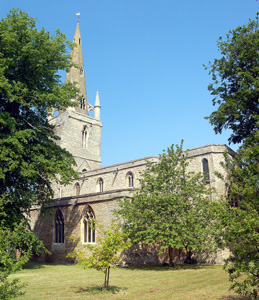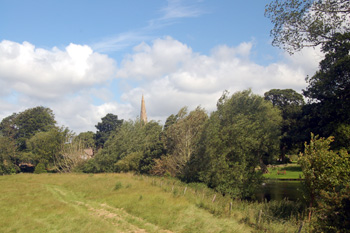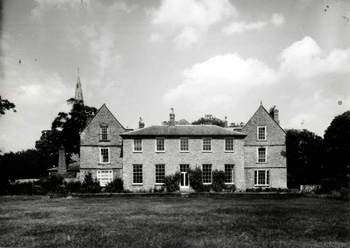Harrold Priory was a small Augustinian nunnery founded in the 1130s, perhaps between 1136 and 1138 and dedicated to the Blessed Virgin Mary and Saint Peter. It was founded by Sampson le Fort and granted to Gervase, Abbot of Saint Nicholas of Arrouaise. The site of this abbey is not known for certain but was somewhere in northern France, perhaps at Mesnil en Arrouaise which lays on the road between Bapaume and Peronne, just behind the German front lines during the Battle of the Somme in 1916.

Harrold church from the south-east - May 2008
The foundation was based on the churches of Harrold and Cold Brayfield [Buckinghamshire]. About 1145 Gervase sent some nuns from Arrouaise to Harrold along with a lay brother simply identified as B. A little later Gervase's brother, Guy, became the first prior. In 1177 Arrouaise ceded control of Harrold to the affiliated Abbey at Great Missenden [Buckinghamshire]. At once Harrold priory protested and gained the support of Pope Alexander III for the matter to be brought to trial. Judgement was finally passed by Master Robert de Bedford, Precentor of Lincoln Cathedral (who may have been not entirely without bias) and the priory won the freedom to govern itself, though paying a yearly pension to Missenden Abbey in compensation, in 1188.
Early references (from 1138 to about 1180) speak of both men and women at the priory, certainly the first priors were men and there are references to the "nuns and the canons who guard them". By 1188 at the latest the prior had been replaced by a prioress and no canon is mentioned after about 1180 but it seems reasonable to assume that canons would have remained for a time in order to help protect the nuns from the outside world, attacks on religious houses were not unknown in England, as the history of Elstow Abbey shows. By 1390, however, no canons seem to have remained, the Clerical Subsidy list of that date showing the vicar of the parish, three chaplains to the house in general, a chaplain specifically for the prioress and a clerk. These were necessary to enact the sacraments such as singing mass or hearing confession, as these were forbidden to women.
The three chaplains to the house in 1390 - Robert Lary, William Yelden and Adam Seyyor all had their own parishes (Lary is described as parson of both Stoke Goldington and Walton [Buckinghamshire], and Seyyor of Great Brickhill [Buckinghamshire] in contemporary deeds) and presumably served as chaplain by rotation. At this time the women at the priory comprised the prioress and nine nuns, the latter being: Joan Causom; Joan Trokesforde; Elizabeth Bewmys; Leticia Tuttebyry; Margaret Wyks; Margaret Northwode; Emmota Drakelowe; Margaret Crouston; Emmota Wendylborogh
A visitation by the Bishop of Lincoln in 1443 recorded a prioress and a sub-prioress and six nuns who were: Emma Welde; Alice Dekun; Agnes Grene; Agnes Tyringham; Thomasine Courteney; Grace Melton; Elizabeth Cotyngham. In 1535 when the house was visited prior to its dissolution a prioress and four or five nuns were mentioned of whom, it was implied, two were unchaste.

Site of Harrold Priory seen from across the river in June 2008
The priory was clearly never large and does not appear to have flourished. It pleaded poverty in 1352 and fifty years later tried to appropriate the parish church of Shakerstone in Leicestershire to augment its income as: "the priory stood hard by the public road or street [presumably today's Odell Road] and had to maintain great and expensive hospitality; that on account of the flooding of a certain great river called the Owse they very often suffered great losses; that its house, buildings and enclosures were in a ruinous state and that its fruits were insufficient for such hospitality, for rebuilding and for other burdens of the prioress and nuns, formerly, as then, thirteen in number".
A partially complete account roll for 1401-1402 has survived in the ownership of the Boteler family and was transcribed by G.D.Gilmore in Volume 49 of the Bedfordshire Historical Records Society publications called Miscellanea [1970]. It shows that the priory made a small surplus but was certainly not rich.
The house's lands were never great, in fact in 1291 Pope Nicholas did not bother to include the house in his taxation of the church. In the Hundred Rolls of 1274-1279 the priory is recorded as owning 410 acres of land. By 1340 this figure had actually fallen to about 360 acres. When the foundation was dissolved it was described as having an income of £57/10/- of which £31 came from four rectories (Harrold, Cold Brayfield, Stevington and Shakerstone) £13/18/- from land in Harrold and £12/12/- from small rents in seventeen different villages

Harrold Hall from the south - built on the site of the Priory [ref: Z53/54/3]
The priory surrendered to the Crown in 1536 as part of the Dissolution of the Monasteries under Henry VIII. Its lands continued as a supposed manor in secular hands. The buildings were replaced by Harrold Hall, built by Francis Farrar between 1608 and 1610 where Hall Close now lies. Medieval coffin lids found in the grounds of the Hall in 1890 confirmed that this was, indeed, the site of the priory.
Dr. Fowler identified the following prioresses, the dates being those they are mentioned in the cartulary:
- 1188: Gila - she came from the Arrouaisian priory of Maroueil near Arras;
- c.1190-1210: Jelita or Julitta who came from the Arrouasian house in Boulogne;
- 1227-1245: Agnes - she died in 1245;
- 1245-1254: Basile Mauduit or Basile de la Lee or Legha, a nun from the priory instituted on the death of Agnes; daughter of Guntolda Mauduit, sister of Harrold landowner Ralph Morin;
- 1262-1268: Amice;
- c.1270: Juliana;
- c.1270-1304: Margery of Hereford; she resigned in 1304; a serious scandal occurred under her rule;
- 1304-1311: Cecily de Cancia; her election was at first declared void but was ultimately approved by the Bishop of Lincoln; she may have been daughter of Thomas de Kent or Cancia and Cecily de Birkin;
- 1335-1354: Petronilla de Rydeware; her institution and resignation dates are all that is known of her;
- 1354-1357: Cristiana Murdac or Murdak; a nun of the priory; she resigned in 1357;
- 1357-1362: Matilda de Tichmersh;
- 1367-1394: Katherine de Tutbury;
- 1394-1434: Emma Drakelowe; a nun of the priory noted in the 1390 Clerical Subsidy;
- 1440-1442: Alice Wautre or Wauter;
- 1452: Thomasina Courtney; a nun of the priory appointed a vicar (though not able to administer the sacraments) of Harrold church on 15 Dec 1452 under the title "administrator of the priory and convent there" - which probably means she was the prioress;
- 1464-1470: Elizabeth Chilteron or Chilton; she resigned in 1470;
- 1470-1474: Margaret Pycard; a nun of the priory;
- 1495-1501: Elena Crabbe; she died in 1501;
- 1501-1509: Eleanor Pygot or Paget; she died in 1509;
- 1509: Agnes Gascoigne or Gascony; a nun from "Shiphay" - if Sheppey is meant it is unusual as it was a Benedictine rather than an Augustinian house;
- 1536; Eleanor Warren: prioress on the dissolution of the priory.